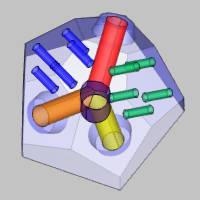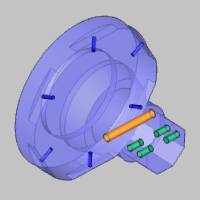|
This section explains Hole Groups and how to define their parameters in the Mill Wizards for all Mill Hole drilling features. This information applies to standard, multiaxis, and cross drilling (Mill Turn). What is a Hole Group?A Hole Group can be one or more holes that share three parameters: Diameter, Top of Feature, and Feature Depth. All holes that you select for a feature that share these parameters are automatically placed into a single Hole Group. Read the following section for further hole group requirements for each drilling type.
Standard Drilling The following images show a standard drilling part with holes at three different levels on the model and two hole diameters. The hole groups for this part are shown with the same color.
Notice the holes that share the same diameter, top of feature, and feature depth have the same color. The software automatically creates the Hole Groups as shown after selecting all of the holes for a single drilling feature.
Multiaxis Drilling In addition to the three shared parameters, multiaxis drilling groups must also share the same tool orientation (tool vector) in order to be grouped.
The following images show a multiaxis drilling part with two hole diameters and five different tool orientations. The hole groups for this part are shown with the same color.
Notice that even though the three larger holes on top have the same diameter, depth, and top of feature, these holes cannot be in a single hole group because they don't share the same tool orientation (tool vector). This is also true for the two sets of smaller holes on the opposing faces, except that they do create two hole groups (shown in blue and green), one for each tool vector.
Cross Drilling Cross drilling hole groups require the same three shared parameters, but the exception here is that the tool orientation/rotation angle does not affect the grouping of holes as it does in multiaxis drilling.
The following images show a part with all cross drill style holes at various locations around the model. There are two hole diameters with holes that share the same top of feature and feature depth. The holes groups created from this part are shown with the same color.
Why Use Hole Groups?Hole groups allow you to define more than one depth for drilling within a single feature. A single hole feature can have one or more hole groups so you can optimize the hole features that you create and eliminate the need for extra features. Hole groups also provide more clearance options, or Group Retracts, to handle the rapid movements between hole groups. Modifying Hole Groups - Feature SettingsThe following information explains the use of hole groups in the Feature page of all Mill Hole Wizards. Using the Hole Groups TableThe Hole Groups section of the Feature settings provides a table for editing Hole Groups and their parameters. You can set the Top of Feature and Feature Depth by typing the values or selecting geometry. You can also break hole groups into separate groups and then regroup them as needed, for example, to modify the rapid movement between holes.
Important: All of the values that display in the Hole Groups table (except Number) can be editing by clicking that item in the table and typing the new value or name. The buttons next to the Hole Groups table are used with the Hole Groups that are selected in the table. When you click a Hole Group in the table, a preview of the holes displays inside the dialog box to help you visualize the parameters for that group.
Number Each hole group is given a number as a reference to the group in the table. This number is automatically created and cannot be edited.
Name Hole groups are automatically named in sequential order with the format of name and number (Group 1). Click the name of any hole group in the table to make it available for editing. Type the new name to create a custom name for the group.
Top of Feature The Top of Feature is the top of the hole as an incremental value from the Machine Setup or machining origin location. Click the Top of Feature value in the table to make it available for editing. Type the new value to set the top of feature for the hole group. After selecting a group in the list, you can use the Pick Top button to set the value using geometry selection.
Important: For multiaxis drilling, the Top of Feature is in reference to the selected geometry, not the machining origin. For cross drilling, the Top of Feature is a radial distance from the center of the part (or the Z-axis of the machining origin for Mill Turn jobs).
Feature Depth The Feature Depth is the depth of the hole as a positive incremental value from the Top of Feature. You can click the value in the table to make it available for editing. Type the new value to set the Feature Depth. You can also use the Pick Bottom button to set the value using geometry selection (after selecting a group in the list). Be sure to properly set the Top of Feature before selecting the Feature Depth.
Tip: For cross drilling (Mill Turn), the Top of Feature and Feature Depth values are calculated as a radial distance from the rotation axis/machining origin. Selecting cylindrical surfaces allows the software to properly calculate both of these values. When using any other geometry type, if the hole extends past the center of the part, you may need to manually type the appropriate Top of Feature and/or Feature Depth value instead of using Pick Top or Pick Bottom.
Counterbore Depth The Counterbore Depth is the depth of the larger hole for counterbore holes. This is a positive incremental value from the Top of Feature. Click the Counterbore Depth value in the table to make it available for editing. After selecting a group in the list, you can use the Pick Counterbore Depth button to set the value using geometry selection.
Break Hole Group The Break Hole Group button breaks the selected Hole Groups into separate single-hole groups. This can only be used when there is more than one hole in the group. Each resulting hole group contains a single hole and the naming follows that of the original group in the format: previous group name, period, new group number (Group 1.1, Group 1.2).
Regroup Holes The Regroup Holes button takes all selected Hole Groups from the list and makes a single hole group. The naming of the new group follows that of the hole group with the lowest number.
Important: In order to regroup holes, the groups that you select must share the same Top of Feature and Feature Depth. Edit these values in the table to be the same for all holes that you want to regroup before clicking Regroup Holes. Note that for multiaxis drilling, holes must also share the same tool orientation or direction vector in order to be grouped.
Pick Top The Pick Top button is used to set the Top of Feature value by selecting geometry such as a point, snap point, or surface edge. Select a Hole Group in the list before clicking Pick Top, or if you don't select a group, you can set the Top of Feature for all groups.
Pick Bottom The Pick Bottom button is used to set the Feature Depth value by selecting geometry such as a point, snap point, or surface edge. Select a Hole Group in the list before clicking Pick Bottom, or if you don't select a group, you can set the Feature Depth for all groups.
Pick Counterbore Bottom The Pick Counterbore Bottom button is used to set the Counterbore Depth value by selecting geometry such as a point, snap point, or surface edge. Select a Hole Group in the list before clicking Pick Counterbore Bottom, or if you don't select a group, you can set the Counterbore Depth for all groups.
Previewing the Hole GroupsTo make it easier to visualize the parameters you are defining, when you click a group in the Hole Groups table, a preview displays inside the dialog box. The preview displays each hole, the machine setup (machining origin), the feature preview (top, bottom, and diameter), and the workpiece if you have selected one for the job.
View Controls The Hole Groups preview uses the
standard mouse controls for altering the viewing position of the
preview.
Viewing the Workpiece The Hole Groups preview may or may not display the part, based on whether or not you have selected a workpiece for the job. Workpiece selection is the first step of using the Stock Wizard, or it can be assigned (or removed) using the Workpiece item in the CAM Tree. Selecting Multiple Hole GroupsThe Hole Groups table allows for multiple selections using standard controls as follows.
Important: You can click anywhere in the row of a group to select that group in the list. When you click any value other than the number, it becomes available for editing. When adding or removing selections using modifier keys (Ctrl or Shift), select a group by clicking its row under the Number column.
Hole Groups - Operation SettingsWhen you go to the Parameters page for any drilling operation in the Mill Hole Wizards, the Hole Groups section displays the name of each Hole Group in the feature. You then select the group name before setting the effective depth, overall depth, and cycle type settings, such as pecking, for each group.
|
||||||||||||||||||||||||||||||||||||||||||||||||||||||||||||||||||||||||














